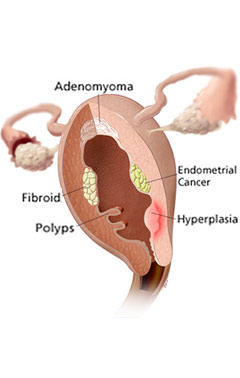|
|
Physical activity Vs Cancer Risk
 Not moving around enough increases your risk of
colon and
breast cancer.
Inactivity may also been linked to cancers of the
womb, lung and prostate. On
the other hand, the good news is that being very active can probably halve your
risk of cancer. Not moving around enough increases your risk of
colon and
breast cancer.
Inactivity may also been linked to cancers of the
womb, lung and prostate. On
the other hand, the good news is that being very active can probably halve your
risk of cancer.
Breast Cancer
Women with low levels of physical activity and higher
body mass index levels are
at more than twice the risk of developing
breast cancer than women who undertake
approximately three metabolic equivalent hours (MET) per day, per year, of
exercise, and have lower BMI levels, the researchers (at Meharry Medical College
and the Vanderbilt-Ingram Cancer Center) found. A 25 kg/m2 body mass index among
Western women is considered to be normal weight, while a BMI of 25 kg/m2 among
Asian women is considered to be in the overweight category and was associated
with an increased breast cancer risk in this study.
Among eleven human studies that took into account many of the established
risk factors for breast cancer, eight reported a decrease in the risk of breast
cancer in pre-menopausal,
postmenopausal or all women with high levels of
physical activity compared to women with low levels of activity.
Level of exercise recommended is equivalent to about 45 minutes of brisk
walking or 20 minutes of vigorous exercise per day. Some studies have reported
that athletes who exercised vigorously and participated in competitive sports
had a lower risk of breast cancer than did non-athletes. However, others have
reported that women who do not participate in competitive sports but who
exercised regularly, such as three hours per week throughout their reproductive
years, had a lower risk of breast cancer as compared to women who never
exercised
Post-menopausal women who walk for an hour a day can cut their chance of breast cancer significantly, a study has suggested. The report, which followed 73,000 women for 17 years, found walking for at least seven hours a week lowered the risk of the disease.
There are several possible biological explanations for the
influence of exercise on the development of breast cancer. Exercise
may:
Influence age at menarche- An early age at menarche, the age
at which a girl has her first menstrual period, is an
established risk factor for breast cancer. Several studies have
reported that girls who exercise regularly have a later age at
menarche compared to inactive girls.
Alter the menstrual cycle- A few studies have reported that
exercise may favorably alter the menstrual cycle. The
alterations in the menstrual cycle caused by exercise may lead
to a decrease in estrogen levels. Estrogen is a hormone
necessary for reproductive development and health in women, but
increased levels of estrogen over a lifetime have been
associated with an increase in the risk of breast cancer.
Activities that lower the level of estrogen in a woman's body
may decrease her risk of developing breast cancer.
Decrease weight gain and overall weight- Some studies have
reported that gaining weight during adulthood and being
overweight as an adult are risk factors for postmenopausal
breast cancer. Physical activity and exercise may help women to
maintain a healthy weight and reduce their risk of breast
cancer. Exercise may be particularly important to help
postmenopausal women avoid weight gain.
Enhance the immune system- Several studies have reported
that moderate exercise may enhance the immune system. A healthy
immune system helps the body fight diseases such as cancer.
|
Endometrial Cancer
 In a population-based case-control study, in-person interviews were completed
among 832 incident endometrial cancer cases and 846 age-matched controls.
Physical activity from exercise, household activities, and transportation was
assessed in adolescence and adulthood, as was lifetime occupational activity.
Women reporting exercise participation in both adolescence and adulthood were at
nearly a 40% reduced risk , compared with women reporting no exercise in either
life period. Postmenopausal women who initiated exercise in adulthood were also
at reduced risk . Reductions in risk were also observed for common lifestyle
activities, including household activity (both life periods) and walking for
transportation (adulthood). Examination of the independent and combined effect
of exercise and lifestyle activities revealed that women with less active
lifestyles but who reported exercise were at 35% reduced risk , whereas
non-exercisers with more active lifestyles were at 40% to 45% reduced risk.
Relative risks associated with obesity range from 2 to 10. Some studies have
concluded that upper-body and central weight confer a higher risk than
peripheral body weight, even after consideration of BMI. In a population-based case-control study, in-person interviews were completed
among 832 incident endometrial cancer cases and 846 age-matched controls.
Physical activity from exercise, household activities, and transportation was
assessed in adolescence and adulthood, as was lifetime occupational activity.
Women reporting exercise participation in both adolescence and adulthood were at
nearly a 40% reduced risk , compared with women reporting no exercise in either
life period. Postmenopausal women who initiated exercise in adulthood were also
at reduced risk . Reductions in risk were also observed for common lifestyle
activities, including household activity (both life periods) and walking for
transportation (adulthood). Examination of the independent and combined effect
of exercise and lifestyle activities revealed that women with less active
lifestyles but who reported exercise were at 35% reduced risk , whereas
non-exercisers with more active lifestyles were at 40% to 45% reduced risk.
Relative risks associated with obesity range from 2 to 10. Some studies have
concluded that upper-body and central weight confer a higher risk than
peripheral body weight, even after consideration of BMI.
Findings suggest that both lifestyle activities of lower intensity (e.g.,
walking and doing household chores) and intentional exercise can reduce
endometrial cancer risk. It has been hypothesized that physical activity
modifies the risk of endometrial cancer by reducing obesity, a known risk factor
for endometrial cancer or by reducing serum estrone levels
Lung Cancer
Current and former heavy smokers who increase their physical activity levels may
lower their risk of getting cancer or dying from the disease according to a new
study by researchers in the Public Health Sciences Division. They found that age
influenced the impact of physical activity on the participants' risk of getting
or dying of specifically,
lung cancer. There was a 25 percent reduction in
cancer deaths in the 54 to 62-year-old smokers. There was also a 16 percent
reduction in the risk of getting lung cancer for this age group. It was observed
that active female smokers lowered their risk of death from lung cancer by 31
percent.
Recommended physical activity is more than eight hours per week of vigorous
session. Moderate activities included housework, yard work, regular walking,
light repair work or carpentry and light sports. Strenuous sports, brisk
walking,
jogging, chopping wood and digging in the garden were among the
activities classified as vigorous.
Colon Cancer
 Most studies show that people who exercise are at lower risk of
colon cancer or
precancerous changes in the colon, compared with sedentary people. Regular
exercise appears to be one factor that will predictably lower the risk of colon
cancer. Physical activity was associated inversely with the risk of large
adenomas (>1 cm) in the distal colon (relative risk 0.57 (95% confidence
interval 0.30 to 1.08)) when high and low quintiles of average weekly energy
expenditure from leisure activities were compared. Much of the benefit was
reported from activities of moderate intensity, such as brisk walking. Most studies show that people who exercise are at lower risk of
colon cancer or
precancerous changes in the colon, compared with sedentary people. Regular
exercise appears to be one factor that will predictably lower the risk of colon
cancer. Physical activity was associated inversely with the risk of large
adenomas (>1 cm) in the distal colon (relative risk 0.57 (95% confidence
interval 0.30 to 1.08)) when high and low quintiles of average weekly energy
expenditure from leisure activities were compared. Much of the benefit was
reported from activities of moderate intensity, such as brisk walking.
Researches support the idea that regular, moderate physical activity (at least
30 minutes per day, at least five days per week) can have a protective effect
against some cancers. Physical activity helps reduce the risk for breast and
prostate cancer by regulating hormone levels in the body, and reduces colon
cancer risk by speeding up the digestive process and limiting the amount of time
the bowel lining is exposed to harmful substances. Exercise also can reduce
cancer risk by helping people maintain a healthy weight.
Consider the following opportunities to increase your activity level:
-
Get on or off the bus one stop early
-
Take the stairs instead of the elevator or escalator
-
When shopping, park the car in the far end of the parking lot
-
Avoid labor-saving devices including the remote control
-
Take a ten-minute walk break rather than a coffee break or cigarette break
-
Go dancing with your partner or with friends
-
Walk the perimeter of the mall two or three times before you begin shopping
-
Exercise during commercial breaks while watching television
-
Work in the garden or mow your lawn
-
Plan active vacations rather than driving trips
Dated 11 October 2013
Related Links
|
|
|
|
|









